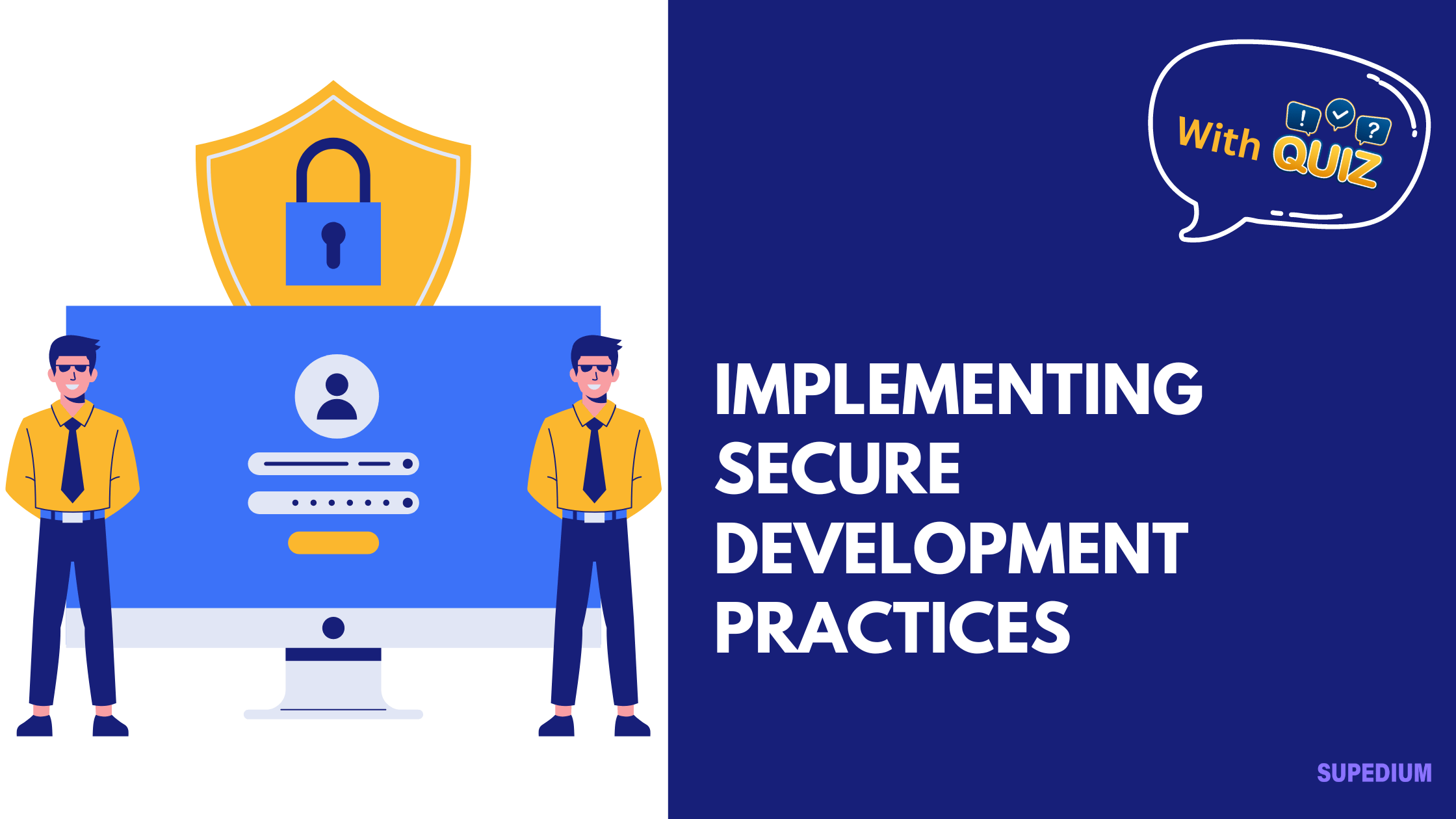Table of Contents
- 0.1 Introduction
- 0.2 Secure Software Development Lifecycle (SDLC)
- 0.3 Secure Coding Practices
- 0.4 Security Tools and Technologies
- 0.5 Secure Development Practices and Frameworks
- 0.6 Training and Awareness
- 0.7 Compliance and Legal Considerations
- 0.8 Case Studies and Real-World Examples
- 0.9 Future Trends and Considerations
- 0.10 Conclusion
- 1 Implementing Secure Development Practices
- 1.1 Introduction
- 1.2 Secure Software Development Lifecycle (SDLC)
- 1.3 Secure Coding Practices
- 1.4 Security Tools and Technologies
- 1.5 Secure Development Practices and Frameworks
- 1.6 Training and Awareness
- 1.7 Compliance and Legal Considerations
- 1.8 Case Studies and Real-World Examples
- 1.9 Future Trends and Considerations
- 1.10 Conclusion
- 2 Quiz Time
![]()
In today’s digital landscape, where data breaches and cyberattacks are becoming increasingly common, implementing secure development practices is not just an option but a necessity. This article provides a comprehensive overview of secure development practices, outlining how to integrate security throughout the software development lifecycle, adopt secure coding practices, leverage security tools, and more.
Introduction
Definition and Importance
Secure development practices involve integrating security measures into every phase of the software development lifecycle (SDLC) to protect against vulnerabilities and threats. As software systems handle sensitive data and face constant security challenges, ensuring that security is baked into the development process is crucial for protecting data confidentiality, integrity, and availability.
Goals of Secure Development Practices
The primary goals of secure development practices include mitigating risks and vulnerabilities, enhancing user trust, ensuring regulatory compliance, and maintaining robust defenses against evolving threats.
Secure Software Development Lifecycle (SDLC)
Overview of SDLC
The Software Development Lifecycle (SDLC) consists of several phases: Planning, Design, Development, Testing, Deployment, and Maintenance. Integrating security into each of these phases helps ensure that security considerations are addressed throughout the entire lifecycle.
Integrating Security into SDLC
- Planning Phase
- Risk Assessment and Threat Modeling: Identify potential threats and vulnerabilities early in the project. Conduct a risk assessment to understand the potential impact of different threats and develop a threat model to address them.
- Security Requirements Gathering: Define security requirements based on risk assessment findings and regulatory obligations. This includes determining the necessary security controls and features needed for the application.
- Design Phase
- Secure Design Principles: Apply principles such as least privilege, defense in depth, and fail-safe defaults to ensure a robust security architecture. Incorporate security design patterns and best practices to mitigate potential threats.
- Security Architecture and Design Patterns: Use proven architectural patterns and practices that promote security, such as separation of concerns and secure communication channels.
- Development Phase
- Secure Coding Practices: Follow secure coding guidelines to prevent common vulnerabilities such as SQL injection, cross-site scripting (XSS), and buffer overflows. Techniques include input validation, output encoding, and secure API usage.
- Code Reviews and Static Code Analysis: Conduct regular code reviews and use static analysis tools to identify and address security issues early in the development process.
- Testing Phase
- Security Testing Techniques: Implement security testing methods such as penetration testing and vulnerability scanning to identify and fix security weaknesses. Regularly update testing methodologies to address new threats.
- Dynamic Analysis and Fuzz Testing: Utilize dynamic analysis tools to examine running applications and fuzz testing to uncover vulnerabilities through random data input.
- Deployment Phase
- Secure Deployment Practices: Ensure that deployment environments are securely configured and that only necessary services are running. Use secure configurations and deployment scripts.
- Configuration Management and Hardening: Implement configuration management practices to maintain secure configurations and perform system hardening to minimize vulnerabilities.
- Maintenance Phase
- Ongoing Security Updates and Patch Management: Regularly update software to address known vulnerabilities and apply patches promptly. Monitor for new security updates and integrate them into the maintenance process.
- Incident Response and Monitoring: Establish incident response plans and monitoring mechanisms to detect and respond to security incidents effectively.
Secure Coding Practices
Input Validation and Data Sanitization
Properly validate and sanitize all user inputs to prevent injection attacks and data corruption. Implement whitelisting for input validation and use parameterized queries to prevent SQL injection.
Authentication and Authorization
Ensure that authentication mechanisms are robust, utilizing multi-factor authentication where applicable. Manage user roles and permissions carefully to enforce least privilege and prevent unauthorized access.
Error Handling and Logging
Handle errors securely by avoiding detailed error messages that could reveal sensitive information. Implement logging and monitoring to track security events and detect potential anomalies.
Security Tools and Technologies
Static Application Security Testing (SAST)
SAST tools analyze source code or binary code for vulnerabilities without executing the application. They help identify security issues early in the development process and can be integrated into the CI/CD pipeline for continuous security assessment.
Dynamic Application Security Testing (DAST)
DAST tools test running applications for vulnerabilities by simulating attacks. They help identify issues that may not be detectable through static analysis and are useful for testing the application in a real-world environment.
Interactive Application Security Testing (IAST)
IAST tools combine elements of both SAST and DAST by analyzing the application’s behavior during runtime. They provide real-time feedback on vulnerabilities and are effective in identifying issues that occur under specific conditions.
Software Composition Analysis (SCA)
SCA tools identify and manage vulnerabilities in third-party libraries and components. They help ensure that open-source and commercial components used in the application do not introduce security risks.
Secure Development Practices and Frameworks
Secure Development Frameworks
Frameworks such as the OWASP Top Ten provide guidelines on common security risks and best practices for mitigating them. Adopting these frameworks helps ensure that development teams are aware of and address prevalent security threats.
Secure Coding Guidelines
Follow secure coding guidelines such as those provided by CERT or other relevant bodies. Tailor these guidelines to specific programming languages and environments to address language-specific vulnerabilities and best practices.
Training and Awareness
Developer Training
Regular security training for developers is essential to keep them informed about emerging threats and secure coding practices. Training should cover topics such as threat modeling, secure coding techniques, and the latest security trends.
Security Awareness Programs
Implement security awareness programs to promote a culture of security within development teams. Encourage practices such as regular security reviews and open communication about security concerns.
Compliance and Legal Considerations
Regulatory Requirements
Adhere to regulatory requirements such as GDPR, CCPA, and HIPAA, which mandate specific security controls and practices. Secure development practices help ensure compliance with these regulations and protect sensitive data.
Legal Implications
Understand the legal implications of security breaches, including potential liability and consequences. Implementing secure development practices helps mitigate the risk of breaches and legal repercussions.
Case Studies and Real-World Examples
Successful Implementations
Examine case studies of organizations that have effectively integrated secure development practices. Analyze the strategies they used and the benefits they realized, such as improved security posture and regulatory compliance.
Security Failures and Breaches
Review notable security breaches resulting from poor development practices. Learn from these failures to understand how vulnerabilities were exploited and how similar issues can be prevented in the future.
Future Trends and Considerations
Emerging Threats
Stay informed about emerging threats and vulnerabilities in the software development landscape. Adapting to new threats involves updating security practices and tools to address evolving risks.
Advances in Security Technologies
Monitor advancements in security technologies, such as AI-driven security tools and automated vulnerability detection. Incorporating these innovations can enhance security practices and improve overall software security.
Conclusion
Summary of Key Points
Implementing secure development practices involves integrating security throughout the software development lifecycle, adopting secure coding practices, leveraging security tools, and ensuring ongoing training and compliance.
The Importance of Continual Improvement
Security is an ongoing process that requires continual learning and adaptation. Regularly review and update security practices to address new threats and vulnerabilities.
Final Thoughts
By proactively integrating security into the development process, organizations can significantly reduce the risk of vulnerabilities and breaches, thereby protecting sensitive data and enhancing user trust. Embracing secure development practices is not only a technical necessity but also a strategic imperative in today’s digital world.
Implementing Secure Development Practices
In today’s digital landscape, where data breaches and cyberattacks are becoming increasingly common, implementing secure development practices is not just an option but a necessity. This article provides a comprehensive overview of secure development practices, outlining how to integrate security throughout the software development lifecycle, adopt secure coding practices, leverage security tools, and more.
Introduction
Definition and Importance
Secure development practices involve integrating security measures into every phase of the software development lifecycle (SDLC) to protect against vulnerabilities and threats. As software systems handle sensitive data and face constant security challenges, ensuring that security is baked into the development process is crucial for protecting data confidentiality, integrity, and availability.
Goals of Secure Development Practices
The primary goals of secure development practices include mitigating risks and vulnerabilities, enhancing user trust, ensuring regulatory compliance, and maintaining robust defenses against evolving threats.
Secure Software Development Lifecycle (SDLC)
Overview of SDLC
The Software Development Lifecycle (SDLC) consists of several phases: Planning, Design, Development, Testing, Deployment, and Maintenance. Integrating security into each of these phases helps ensure that security considerations are addressed throughout the entire lifecycle.
Integrating Security into SDLC
- Planning Phase
- Risk Assessment and Threat Modeling: Identify potential threats and vulnerabilities early in the project. Conduct a risk assessment to understand the potential impact of different threats and develop a threat model to address them.
- Security Requirements Gathering: Define security requirements based on risk assessment findings and regulatory obligations. This includes determining the necessary security controls and features needed for the application.
- Design Phase
- Secure Design Principles: Apply principles such as least privilege, defense in depth, and fail-safe defaults to ensure a robust security architecture. Incorporate security design patterns and best practices to mitigate potential threats.
- Security Architecture and Design Patterns: Use proven architectural patterns and practices that promote security, such as separation of concerns and secure communication channels.
- Development Phase
- Secure Coding Practices: Follow secure coding guidelines to prevent common vulnerabilities such as SQL injection, cross-site scripting (XSS), and buffer overflows. Techniques include input validation, output encoding, and secure API usage.
- Code Reviews and Static Code Analysis: Conduct regular code reviews and use static analysis tools to identify and address security issues early in the development process.
- Testing Phase
- Security Testing Techniques: Implement security testing methods such as penetration testing and vulnerability scanning to identify and fix security weaknesses. Regularly update testing methodologies to address new threats.
- Dynamic Analysis and Fuzz Testing: Utilize dynamic analysis tools to examine running applications and fuzz testing to uncover vulnerabilities through random data input.
- Deployment Phase
- Secure Deployment Practices: Ensure that deployment environments are securely configured and that only necessary services are running. Use secure configurations and deployment scripts.
- Configuration Management and Hardening: Implement configuration management practices to maintain secure configurations and perform system hardening to minimize vulnerabilities.
- Maintenance Phase
- Ongoing Security Updates and Patch Management: Regularly update software to address known vulnerabilities and apply patches promptly. Monitor for new security updates and integrate them into the maintenance process.
- Incident Response and Monitoring: Establish incident response plans and monitoring mechanisms to detect and respond to security incidents effectively.
Secure Coding Practices
Input Validation and Data Sanitization
Properly validate and sanitize all user inputs to prevent injection attacks and data corruption. Implement whitelisting for input validation and use parameterized queries to prevent SQL injection.
Authentication and Authorization
Ensure that authentication mechanisms are robust, utilizing multi-factor authentication where applicable. Manage user roles and permissions carefully to enforce least privilege and prevent unauthorized access.
Error Handling and Logging
Handle errors securely by avoiding detailed error messages that could reveal sensitive information. Implement logging and monitoring to track security events and detect potential anomalies.
Security Tools and Technologies
Static Application Security Testing (SAST)
SAST tools analyze source code or binary code for vulnerabilities without executing the application. They help identify security issues early in the development process and can be integrated into the CI/CD pipeline for continuous security assessment.
Dynamic Application Security Testing (DAST)
DAST tools test running applications for vulnerabilities by simulating attacks. They help identify issues that may not be detectable through static analysis and are useful for testing the application in a real-world environment.
Interactive Application Security Testing (IAST)
IAST tools combine elements of both SAST and DAST by analyzing the application’s behavior during runtime. They provide real-time feedback on vulnerabilities and are effective in identifying issues that occur under specific conditions.
Software Composition Analysis (SCA)
SCA tools identify and manage vulnerabilities in third-party libraries and components. They help ensure that open-source and commercial components used in the application do not introduce security risks.
Secure Development Practices and Frameworks
Secure Development Frameworks
Frameworks such as the OWASP Top Ten provide guidelines on common security risks and best practices for mitigating them. Adopting these frameworks helps ensure that development teams are aware of and address prevalent security threats.
Secure Coding Guidelines
Follow secure coding guidelines such as those provided by CERT or other relevant bodies. Tailor these guidelines to specific programming languages and environments to address language-specific vulnerabilities and best practices.
Training and Awareness
Developer Training
Regular security training for developers is essential to keep them informed about emerging threats and secure coding practices. Training should cover topics such as threat modeling, secure coding techniques, and the latest security trends.
Security Awareness Programs
Implement security awareness programs to promote a culture of security within development teams. Encourage practices such as regular security reviews and open communication about security concerns.
Compliance and Legal Considerations
Regulatory Requirements
Adhere to regulatory requirements such as GDPR, CCPA, and HIPAA, which mandate specific security controls and practices. Secure development practices help ensure compliance with these regulations and protect sensitive data.
Legal Implications
Understand the legal implications of security breaches, including potential liability and consequences. Implementing secure development practices helps mitigate the risk of breaches and legal repercussions.
Case Studies and Real-World Examples
Successful Implementations
Examine case studies of organizations that have effectively integrated secure development practices. Analyze the strategies they used and the benefits they realized, such as improved security posture and regulatory compliance.
Security Failures and Breaches
Review notable security breaches resulting from poor development practices. Learn from these failures to understand how vulnerabilities were exploited and how similar issues can be prevented in the future.
Future Trends and Considerations
Emerging Threats
Stay informed about emerging threats and vulnerabilities in the software development landscape. Adapting to new threats involves updating security practices and tools to address evolving risks.
Advances in Security Technologies
Monitor advancements in security technologies, such as AI-driven security tools and automated vulnerability detection. Incorporating these innovations can enhance security practices and improve overall software security.
Conclusion
Summary of Key Points
Implementing secure development practices involves integrating security throughout the software development lifecycle, adopting secure coding practices, leveraging security tools, and ensuring ongoing training and compliance.
The Importance of Continual Improvement
Security is an ongoing process that requires continual learning and adaptation. Regularly review and update security practices to address new threats and vulnerabilities.
Final Thoughts
By proactively integrating security into the development process, organizations can significantly reduce the risk of vulnerabilities and breaches, thereby protecting sensitive data and enhancing user trust. Embracing secure development practices is not only a technical necessity but also a strategic imperative in today’s digital world.






Be the first to comment